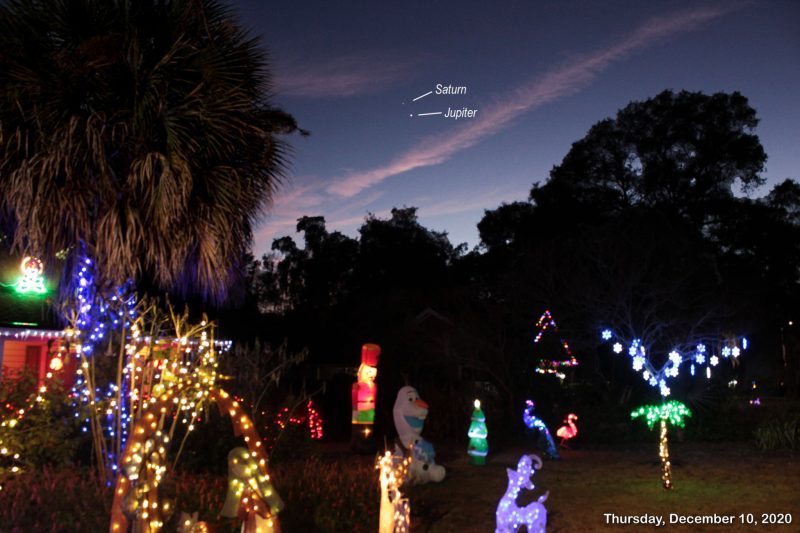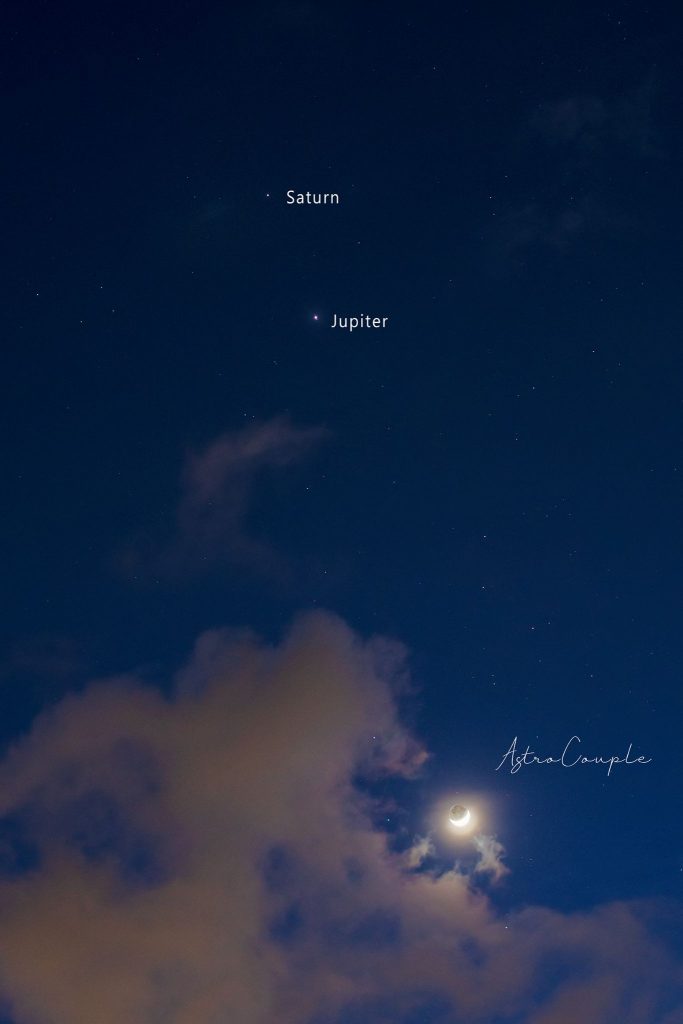
You might – or might not – catch the young whisker-thin moon below the planets Jupiter and Saturn on December 15, 2020. You’ll surely catch the moon and these glorious planets in the west after sunset on December 16, 17 and 18. Giant Jupiter and golden, ringed Saturn are now nearing their December 21 great conjunction. They will be a dazzling and exceedingly rare sight near the young moon in our evening sky. Don’t miss them!
On December 15, the frail waxing crescent moon will be sitting low in the sky, and close to the sunset point on the horizon. Shortly thereafter – most likely before nightfall – the moon will be following the sun beneath the horizon. On December 15, you might need binoculars to tease out the lunar crescent from glow of evening twilight. Meanwhile, Jupiter and Saturn will be shining above the moon – above the sunset point – both bright and very close together!
On December 16, 17 and 18, think photo opportunity as the young crescent moon moves past Jupiter and Saturn, the two largest planets in our solar system. Jupiter is the larger and brighter of these two brilliant beauties, outshining Saturn by 11 times. So if you see Jupiter and not Saturn, aim binoculars at Jupiter to see both Jupiter and Saturn taking stage in the same binocular field of view. If if you get a good photo, submit it here to EarthSky’s Community Photos.
Read more: All you need to know Jupiter and Saturn’s December 21 great conjunction
See photos: Editors’ pics of Jupiter and Saturn as they draw closer
Read more: Will Jupiter and Saturn appear as a “Christmas star” in 2020?

View at EarthSky Community Photos. | Patrick Prokop in Savannah, Georgia caught Jupiter and Saturn close together on December 10, 2020, above a display of holidays lights. Thanks, Patrick! Start watching now, and see the bright couple draw closer to one another between now and December 21! See more photos of Jupiter and Saturn drawing near.
Given clear skies, it’ll be easier to see the moon each day after December 15 for three reasons:
A greater portion of the lunar disk will be illuminated by sunlight.
The moon will be higher up in the sky at sunset.
The moon will stay out longer after sundown.
Live in the United States or Canada? Click on Old Farmer’s Almanac to find out the moon’s setting time in your sky.
For the world as a whole, find out the moon’s setting time at TimeandDate or Sunrise Sunset Calendars (check Moonrise and moonset box)

View at EarthSky Community Photos. | Emma Zulaiha Zulkifli in Kota Kinabalu, Malaysia, captured this photo of Saturn, Jupiter and the waxing crescent moon last month (November 18, 2020). The 2 giant planets will be much closer together during this month’s dramatic passage of the moon (December 15-18). Thank you, Emma!
Jupiter-Saturn conjunctions happen every 20 years. The last one was in the year 2000. However, the 2020 great conjunction of Jupiter and Saturn will be the closest since 1623 and the closest observable since 1226! On December 21, Jupiter and Saturn will be only 0.1 degree apart. Some say the pair will look like an “elongated star” on that date. Will they? Or will they look like a double planet? To know for sure, we’ll have to look and see.
2002’s extra-close Jupiter-Saturn conjunction won’t be matched again until the Jupiter-Saturn conjunction of March 15, 2080.
Jupiter-Saturn conjunctions from 2000 to 2100 inclusive:
May 31, 2000
December 21, 2020
November 5, 2040
April 10, 2060
March 15, 2080
September 24, 2100
Bottom line: For a sky challenge, try catching the very young moon near the western horizon, shortly after sunset on December 15, 2020. The two bright shining objects above it will be Jupiter and Saturn, now nearing their great conjunction on December 21. On December 16, 17 and 18, watch for a wider lunar crescent to sweep past Jupiter and Saturn.
from EarthSky https://ift.tt/37gFyop

You might – or might not – catch the young whisker-thin moon below the planets Jupiter and Saturn on December 15, 2020. You’ll surely catch the moon and these glorious planets in the west after sunset on December 16, 17 and 18. Giant Jupiter and golden, ringed Saturn are now nearing their December 21 great conjunction. They will be a dazzling and exceedingly rare sight near the young moon in our evening sky. Don’t miss them!
On December 15, the frail waxing crescent moon will be sitting low in the sky, and close to the sunset point on the horizon. Shortly thereafter – most likely before nightfall – the moon will be following the sun beneath the horizon. On December 15, you might need binoculars to tease out the lunar crescent from glow of evening twilight. Meanwhile, Jupiter and Saturn will be shining above the moon – above the sunset point – both bright and very close together!
On December 16, 17 and 18, think photo opportunity as the young crescent moon moves past Jupiter and Saturn, the two largest planets in our solar system. Jupiter is the larger and brighter of these two brilliant beauties, outshining Saturn by 11 times. So if you see Jupiter and not Saturn, aim binoculars at Jupiter to see both Jupiter and Saturn taking stage in the same binocular field of view. If if you get a good photo, submit it here to EarthSky’s Community Photos.
Read more: All you need to know Jupiter and Saturn’s December 21 great conjunction
See photos: Editors’ pics of Jupiter and Saturn as they draw closer
Read more: Will Jupiter and Saturn appear as a “Christmas star” in 2020?

View at EarthSky Community Photos. | Patrick Prokop in Savannah, Georgia caught Jupiter and Saturn close together on December 10, 2020, above a display of holidays lights. Thanks, Patrick! Start watching now, and see the bright couple draw closer to one another between now and December 21! See more photos of Jupiter and Saturn drawing near.
Given clear skies, it’ll be easier to see the moon each day after December 15 for three reasons:
A greater portion of the lunar disk will be illuminated by sunlight.
The moon will be higher up in the sky at sunset.
The moon will stay out longer after sundown.
Live in the United States or Canada? Click on Old Farmer’s Almanac to find out the moon’s setting time in your sky.
For the world as a whole, find out the moon’s setting time at TimeandDate or Sunrise Sunset Calendars (check Moonrise and moonset box)

View at EarthSky Community Photos. | Emma Zulaiha Zulkifli in Kota Kinabalu, Malaysia, captured this photo of Saturn, Jupiter and the waxing crescent moon last month (November 18, 2020). The 2 giant planets will be much closer together during this month’s dramatic passage of the moon (December 15-18). Thank you, Emma!
Jupiter-Saturn conjunctions happen every 20 years. The last one was in the year 2000. However, the 2020 great conjunction of Jupiter and Saturn will be the closest since 1623 and the closest observable since 1226! On December 21, Jupiter and Saturn will be only 0.1 degree apart. Some say the pair will look like an “elongated star” on that date. Will they? Or will they look like a double planet? To know for sure, we’ll have to look and see.
2002’s extra-close Jupiter-Saturn conjunction won’t be matched again until the Jupiter-Saturn conjunction of March 15, 2080.
Jupiter-Saturn conjunctions from 2000 to 2100 inclusive:
May 31, 2000
December 21, 2020
November 5, 2040
April 10, 2060
March 15, 2080
September 24, 2100
Bottom line: For a sky challenge, try catching the very young moon near the western horizon, shortly after sunset on December 15, 2020. The two bright shining objects above it will be Jupiter and Saturn, now nearing their great conjunction on December 21. On December 16, 17 and 18, watch for a wider lunar crescent to sweep past Jupiter and Saturn.
from EarthSky https://ift.tt/37gFyop

Aucun commentaire:
Enregistrer un commentaire